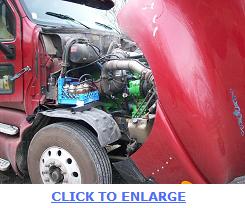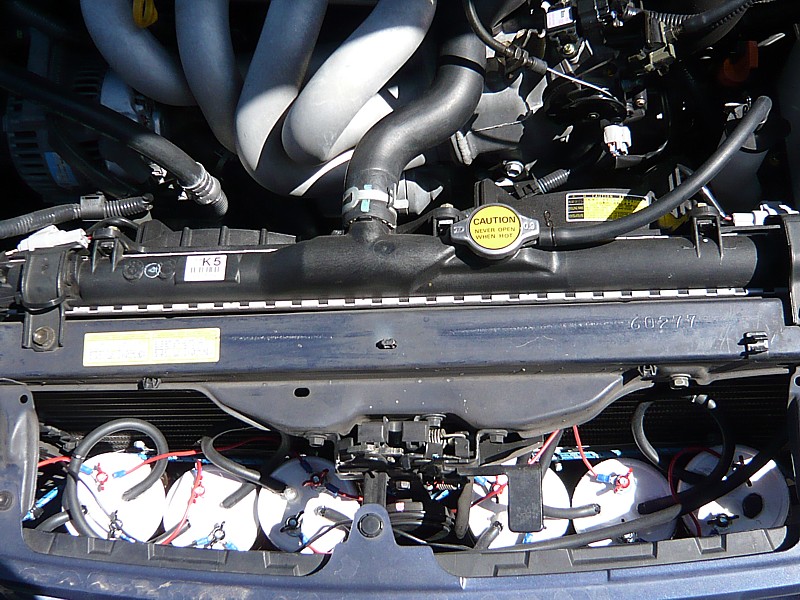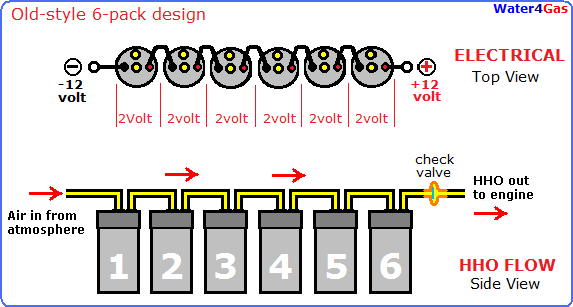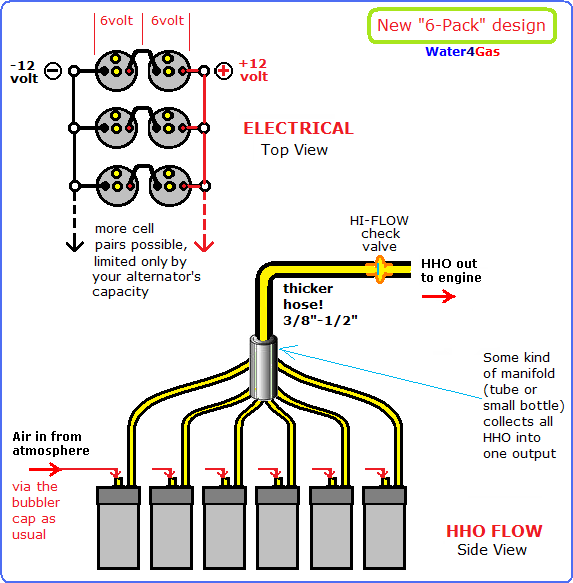This
page may not
function properly in Internet Explorer - please switch to Firefox
      
     
    
   
  
 
 ~~~
~~~
*
MULTI-CELL
 WHAT CAN THIS DO FOR ME? WHAT CAN THIS DO FOR ME?
Before we go into the technicalities, you must know that we've
had
success lately with the use of this simple design on a big rig (large
truck) - gained 26% (from 5.5-6 MPG to 7-7.5 MPG) with our Multi-Cell
design.
The driver/owner is now saving between $200 and $400/week,
depending on
load and terrain.
Proof posted at Water4Trucks
WHY USE MULTI-CELL?
The great advantages of the multi-cell design, and how it
functions chemically better than a single cell, are described in my
e-book ("Modify Your Car to Save
Gas USING WATER", or "User Manual").
But let me tell you in short: The more cells, the less heat
and more HHO (Hydrogen-Oxygen gas or "Brown's Gas"). Or more
correctly: higher energy efficiency for HHO production. This is true up
to 6 or 7 cells max.
If space in the engine compartment
allows, a chain of six cells can be used which means each receives
about two volts and the waste power is reduced to an absolute minimum -
while the gas production is six times higher. I used 6 glass jars and
positioned them between the radiator and the
front bumper of my Toyota Corolla (click the photo to enlarge):

CLICK TO ENLARGE
Let's summarize the benefits of the multi-cell:
1. Multiply HHO production,
2. Reduce heat,
3. More water stored in the system.
HOW TO BUILD A MULTI-CELL
GENERAL DESCRIPTION AND THE "OLD" DESIGN
By "old" is meant about 1 year, in this ever-changing industry
of ours... We will look at the new design in a minute, but first lets
take a look at the basics. This is particularly important to know for
those who are already familiar with  six-cell or "6-pack" as they nick-named it. six-cell or "6-pack" as they nick-named it.
If there is room in the engine compartment, then anything up
to seven of these cells may be installed and connected in series across the battery. The
old multi-cell design had
a hard-to-make pipework that was daisy-chained from one cell to
another. The air was being drawn into the engine passing through each
cell, picking up more and more gas on the way, as shown below:

The upper part of the diagram
shows the electrical connection
between the cells while the lower part of the diagram shows how the
hoses are connected. While the cells are shown side by side in the
diagram, they can be positioned in any convenient location(s) in the
engine compartment. As the temperature in the engine compartment can be
quite high, the cell housings needs to be unaffected by high
temperatures, which make some plastic containers unsuitable for this
use.
THE NEW DESIGN

The old design gave my car 61 MPG, and the new "6-pack" design
is expected to improve at least 10 MPG on top of that. The new  multi-cell improves on the old one in several
key factors: multi-cell improves on the old one in several
key factors:
- First of all, each single device is built with the same
materials, structure and procedures described in my e-books, so they
can now be duplicated more easily. From personal experience I can tell
you, this standardization alone will make it much easier on you. The
old design had a tricky plumbing.
- It allows for expansion to any number of cells. You can
build a "12-pack" and place it in the trunk, or go wherever the
imagination takes you. How about 36-pack? Why not? If your engine is
large and
your alternator can take it, I can see no reason why not.
- Electrical connection: instead of all cells (Electrolyzers)
in series, it's only two in series, giving 6 Volts to each cell.
Through trial and error I FOUND 6
VOLTS TO BE THE OPTIMAL VOLTAGE WHEN
WORKING WITH BAKING SODA.
- The mechanical design of the electrolyzer has been updated
to fit the new chemistry balance of Baking Soda, or in other words
designed to give out more Hydrogen-Oxygen at 6 volts (rather than 12
volts of the single cell, and not 2 volts either of traditional
designs).
INSTALLATION CONSIDERATIONS
The way to connect a multi-cell to the engine is pretty simple
and straightforward as described in my e-book ("Modify Your Car to Save
Gas USING WATER", or "User Manual"). If you're using the dual HHO
connection, which means you supply HHO to both the Intake Manifold of
the engine AND the Air Intake, then two output check valves are
recommended as usual.
One last remark: in my opinion there is no room for a sloppy
job when it comes to a multi-cell arrangement of any size. Since there
are many more places that the electrical connection or the mechanical
connection can go wrong, you have to make sure that:
- There are no loose electrical connections, and
- There are no vacuum leaks anywhere on the Electrolyzers,
the 6-pack manifold or the hose leading to the engine.
How Can Anyone...
BUILD A 6-PACK CHEAPLY?
...and you also need to know:
-HOW TO USE THEM TO MAXIMIZE
YOUR ECONOMY?
If you don't have these e-books yet, all the answers are
there. Order your copy today:
This
e-book is about the TECHNOLOGY
|
This
e-book is about your $$$ SAVINGS
|
 |
183 pages
Unique
info!
|
 |
137 pages
Unique
Info!
|
|
|
|
|














